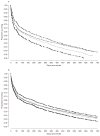Secondary stroke prevention strategies for the oldest patients: possibilities and challenges
- PMID: 19358617
- PMCID: PMC3740382
- DOI: 10.2165/00002512-200926030-00003
Secondary stroke prevention strategies for the oldest patients: possibilities and challenges
Abstract
Older adults are not only at higher risk of experiencing stroke, but also have multiple co-morbidities that make treatment for secondary stroke prevention challenging. Very few clinical trials specifically related to secondary stroke prevention treatment efficacy have focused on the oldest-old (>or=85 years) and, therefore, evidence-based recommendations for treatment specific to this population are not available. Some of the special considerations for stroke prevention treatments in older patients include careful titration of blood-pressure-lowering drugs to avoid hypotension, the risk of haemorrhagic stroke with HMG-CoA reductase inhibitors (statins) and weighing the risk of recurrent ischaemia versus bleeding in patients taking antiplatelet or anticoagulant therapy. The risk of peri-procedural complications appears to be high with both carotid angioplasty and stenting and carotid endarterectomy in older patients with carotid stenosis. Other common issues in older patients include adverse drug events, recognizing the risk of dementia, depression and osteoporosis and deciding when to discontinue secondary stroke prevention. In this review, we provide the practitioner with the evidence related to specific approaches to secondary stroke prevention in older patients, and identify the knowledge gaps that currently limit our ability to appropriately treat this vulnerable population.
Conflict of interest statement
Cathleen Colón-Emeric has no conflicts of interest that are directly relevant to the content of this review.
Figures

Similar articles
-
Secondary prevention of stroke: a practical guide to drug treatment.CNS Drugs. 2004;18(4):221-41. doi: 10.2165/00023210-200418040-00003. CNS Drugs. 2004. PMID: 15015903 Review.
-
Statins reduce peri-procedural complications in carotid stenting.Eur J Vasc Endovasc Surg. 2014 Dec;48(6):626-32. doi: 10.1016/j.ejvs.2014.08.010. Epub 2014 Sep 16. Eur J Vasc Endovasc Surg. 2014. PMID: 25240903
-
Ischemic stroke and secondary prevention in clinical practice: a cohort study of 14,529 patients in the Swedish Stroke Register.Stroke. 2010 Jul;41(7):1338-42. doi: 10.1161/STROKEAHA.110.580209. Epub 2010 Jun 3. Stroke. 2010. PMID: 20522818
-
Preventing ischemic stroke in the older adult.Cleve Clin J Med. 2005 Oct;72 Suppl 3:S14-25. doi: 10.3949/ccjm.72.suppl_3.s14. Cleve Clin J Med. 2005. PMID: 16265940 Review.
-
Key articles and guidelines in the acute management and secondary prevention of ischemic stroke.Pharmacotherapy. 2013 Jun;33(6):e115-42. doi: 10.1002/phar.1252. Epub 2013 Feb 11. Pharmacotherapy. 2013. PMID: 23401103
Cited by
-
Secondary Stroke Prevention After Ischemic Stroke in Patients with Alzheimer's Disease and Other Dementia Disorders.J Alzheimers Dis. 2020;73(3):1013-1021. doi: 10.3233/JAD-191011. J Alzheimers Dis. 2020. PMID: 31884483 Free PMC article.
-
Stroke in Older Survivors of Ischemic Stroke: Standard Care or Something Different?Geriatrics (Basel). 2017 Jun 19;2(2):18. doi: 10.3390/geriatrics2020018. Geriatrics (Basel). 2017. PMID: 31011028 Free PMC article.
-
Change in Prescribing for Secondary Prevention of Stroke and Coronary Heart Disease in Finnish Nursing Homes and Assisted Living Facilities.Drugs Aging. 2019 Jun;36(6):571-579. doi: 10.1007/s40266-019-00656-x. Drugs Aging. 2019. PMID: 30949985
-
Stroke prevalence and associated factors among older patients with hypertension attending public healthcare facilities in Greater Kampala Metropolitan Area, Uganda.Res Sq [Preprint]. 2025 Feb 3:rs.3.rs-5867126. doi: 10.21203/rs.3.rs-5867126/v1. Res Sq. 2025. PMID: 39975928 Free PMC article. Preprint.
-
Navigating the gray zones of stroke management for a graying population.Cerebrovasc Dis. 2010;29(6):523-7. doi: 10.1159/000302737. Epub 2010 Mar 30. Cerebrovasc Dis. 2010. PMID: 20357437 Free PMC article. No abstract available.
References
-
- Rosamond W, Flegal K, Furie K, et al. Heart disease and stroke statistics – 2008 update: a report from the American Heart Association Statistics Committee and Stroke Statistics Subcommittee. Circulation. 2008;117 (4):e25–146. - PubMed
-
- Muntner P, Garrett E, Klag MJ, et al. Trends in stroke prevalence between 1973 and 1991 in the US population 25 to 74 years of age. Stroke. 2002;33 (5):1209–13. - PubMed
-
- Kaplan RC, Tirschwell DL, Longstreth WT, Jr, et al. Vascular events, mortality, and preventive therapy following ischemic stroke in the elderly. Neurology. 2005;65 (6):835–42. - PubMed
Publication types
MeSH terms
Grants and funding
LinkOut - more resources
Full Text Sources
Other Literature Sources
Medical

